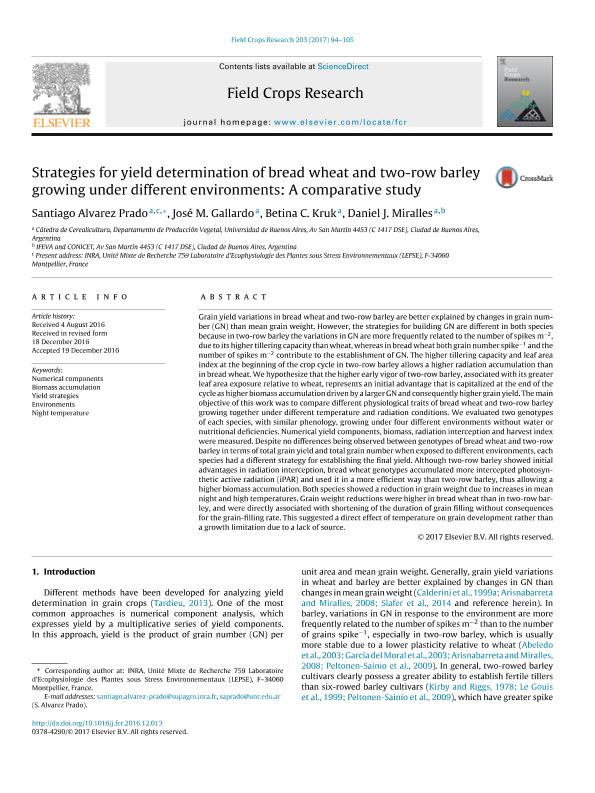Artículo
Strategies for yield determination of bread wheat and two-row barley growing under different environments: A comparative study
Fecha de publicación:
03/2017
Editorial:
Elsevier Science
Revista:
Field Crops Research
ISSN:
0378-4290
Idioma:
Inglés
Tipo de recurso:
Artículo publicado
Clasificación temática:
Resumen
Grain yield variations in bread wheat and two-row barley are better explained by changes in grain number (GN) than mean grain weight. However, the strategies for building GN are different in both species because in two-row barley the variations in GN are more frequently related to the number of spikes m−2, due to its higher tillering capacity than wheat, whereas in bread wheat both grain number spike−1 and the number of spikes m−2 contribute to the establishment of GN. The higher tillering capacity and leaf area index at the beginning of the crop cycle in two-row barley allows a higher radiation accumulation than in bread wheat. We hypothesize that the higher early vigor of two-row barley, associated with its greater leaf area exposure relative to wheat, represents an initial advantage that is capitalized at the end of the cycle as higher biomass accumulation driven by a larger GN and consequently higher grain yield. The main objective of this work was to compare different physiological traits of bread wheat and two-row barley growing together under different temperature and radiation conditions. We evaluated two genotypes of each species, with similar phenology, growing under four different environments without water or nutritional deficiencies. Numerical yield components, biomass, radiation interception and harvest index were measured. Despite no differences being observed between genotypes of bread wheat and two-row barley in terms of total grain yield and total grain number when exposed to different environments, each species had a different strategy for establishing the final yield. Although two-row barley showed initial advantages in radiation interception, bread wheat genotypes accumulated more intercepted photosynthetic active radiation (iPAR) and used it in a more efficient way than two-row barley, thus allowing a higher biomass accumulation. Both species showed a reduction in grain weight due to increases in mean night and high temperatures. Grain weight reductions were higher in bread wheat than in two-row barley, and were directly associated with shortening of the duration of grain filling without consequences for the grain-filling rate. This suggested a direct effect of temperature on grain development rather than a growth limitation due to a lack of source.
Archivos asociados
Licencia
Identificadores
Colecciones
Articulos(IFEVA)
Articulos de INST.D/INV.FISIOLOGICAS Y ECO.VINCULADAS A L/AGRIC
Articulos de INST.D/INV.FISIOLOGICAS Y ECO.VINCULADAS A L/AGRIC
Citación
Alvarez Prado, Santiago; Gallardo, Jose M.; Kruk, Betina Claudia; Miralles, Daniel Julio; Strategies for yield determination of bread wheat and two-row barley growing under different environments: A comparative study; Elsevier Science; Field Crops Research; 203; 3-2017; 94-105
Compartir
Altmétricas




